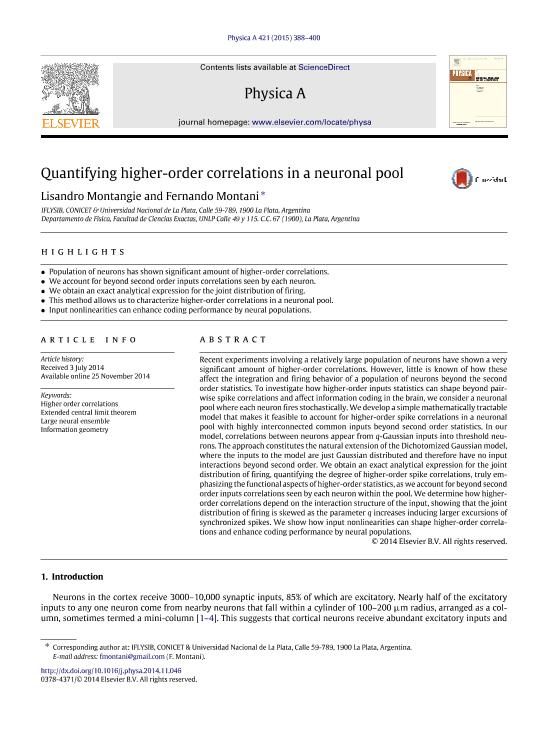Mostrar el registro sencillo del ítem
dc.contributor.author
Montangie, Lisandro

dc.contributor.author
Montani, Fernando Fabián

dc.date.available
2021-12-13T05:31:19Z
dc.date.issued
2015-03-01
dc.identifier.citation
Montangie, Lisandro; Montani, Fernando Fabián; Quantifying higher-order correlations in a neuronal pool; Elsevier Science; Physica A: Statistical Mechanics and its Applications; 421; 1; 1-3-2015; 388-400
dc.identifier.issn
0378-4371
dc.identifier.uri
http://hdl.handle.net/11336/148575
dc.description.abstract
Recent experiments involving a relatively large population of neurons have shown a very significant amount of higher-order correlations. However, little is known of how these affect the integration and firing behavior of a population of neurons beyond the second order statistics. To investigate how higher-order inputs statistics can shape beyond pairwise spike correlations and affect information coding in the brain, we consider a neuronal pool where each neuron fires stochastically. We develop a simple mathematically tractable model that makes it feasible to account for higher-order spike correlations in a neuronal pool with highly interconnected common inputs beyond second order statistics. In our model, correlations between neurons appear from q-Gaussian inputs into threshold neurons. The approach constitutes the natural extension of the Dichotomized Gaussian model, where the inputs to the model are just Gaussian distributed and therefore have no input interactions beyond second order. We obtain an exact analytical expression for the joint distribution of firing, quantifying the degree of higher-order spike correlations, truly emphasizing the functional aspects of higher-order statistics, as we account for beyond second order inputs correlations seen by each neuron within the pool. We determine how higher-order correlations depend on the interaction structure of the input, showing that the joint distribution of firing is skewed as the parameter q increases inducing larger excursions of synchronized spikes. We show how input nonlinearities can shape higher-order correlations and enhance coding performance by neural populations.
dc.format
application/pdf
dc.language.iso
eng
dc.publisher
Elsevier Science

dc.rights
info:eu-repo/semantics/openAccess
dc.rights.uri
https://creativecommons.org/licenses/by-nc-sa/2.5/ar/
dc.subject
EXTENDED CENTRAL LIMIT THEOREM
dc.subject
HIGHER ORDER CORRELATIONS
dc.subject
INFORMATION GEOMETRY
dc.subject
LARGE NEURAL ENSEMBLE
dc.subject.classification
Otras Ciencias Físicas

dc.subject.classification
Ciencias Físicas

dc.subject.classification
CIENCIAS NATURALES Y EXACTAS

dc.title
Quantifying higher-order correlations in a neuronal pool
dc.type
info:eu-repo/semantics/article
dc.type
info:ar-repo/semantics/artículo
dc.type
info:eu-repo/semantics/publishedVersion
dc.date.updated
2021-04-23T19:05:00Z
dc.journal.volume
421
dc.journal.number
1
dc.journal.pagination
388-400
dc.journal.pais
Países Bajos

dc.journal.ciudad
Amsterdam
dc.description.fil
Fil: Montangie, Lisandro. Universidad Nacional de La Plata. Facultad de Ciencias Exactas. Departamento de Física; Argentina. Consejo Nacional de Investigaciones Científicas y Técnicas. Centro Científico Tecnológico Conicet - La Plata. Instituto de Física de Líquidos y Sistemas Biológicos. Universidad Nacional de La Plata. Facultad de Ciencias Exactas. Instituto de Física de Líquidos y Sistemas Biológicos; Argentina
dc.description.fil
Fil: Montani, Fernando Fabián. Consejo Nacional de Investigaciones Científicas y Técnicas. Centro Científico Tecnológico Conicet - La Plata. Instituto de Física de Líquidos y Sistemas Biológicos. Universidad Nacional de La Plata. Facultad de Ciencias Exactas. Instituto de Física de Líquidos y Sistemas Biológicos; Argentina. Universidad Nacional de La Plata. Facultad de Ciencias Exactas. Departamento de Física; Argentina
dc.journal.title
Physica A: Statistical Mechanics and its Applications

dc.relation.alternativeid
info:eu-repo/semantics/altIdentifier/url/http://www.sciencedirect.com/science/article/pii/S0378437114010048
dc.relation.alternativeid
info:eu-repo/semantics/altIdentifier/doi/http://dx.doi.org/10.1016/j.physa.2014.11.046
Archivos asociados
